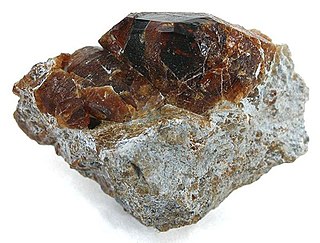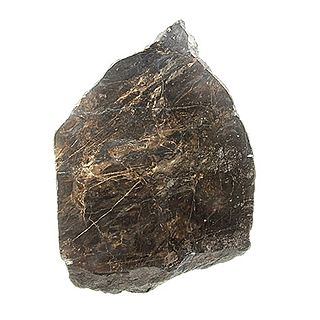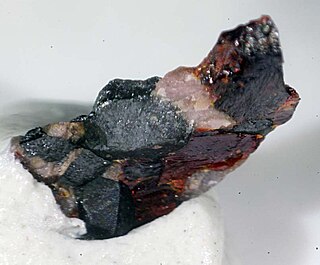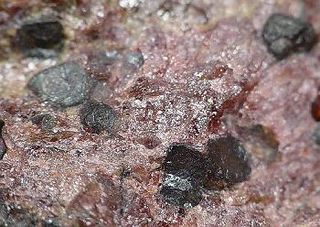
Lazurite, old name Azure spar is a tectosilicate mineral with sulfate, sulfur and chloride with formula (Na,Ca)8[(S,Cl,SO4,OH)2|(Al6Si6O24)]. It is a feldspathoid and a member of the sodalite group. Lazurite crystallizes in the isometric system although well‐formed crystals are rare. It is usually massive and forms the bulk of the gemstone lapis lazuli.

Silicate minerals are rock-forming minerals made up of silicate groups. They are the largest and most important class of minerals and make up approximately 90 percent of Earth's crust.

Tephroite is the manganese endmember of the olivine group of nesosilicate minerals with the formula Mn2SiO4. A solid solution series exists between tephroite and its analogues, the group endmembers fayalite and forsterite. Divalent iron or magnesium may readily replace manganese in the olivine crystal structure.

Clinohumite is an uncommon member of the humite group, a magnesium silicate according to the chemical formula (Mg, Fe)9(SiO4)4(F,OH)2. The formula can be thought of as four olivine (Mg2SiO4), plus one brucite (Mg(OH)2). Indeed, the mineral is essentially a hydrated olivine and occurs in altered ultramafic rocks and carbonatites. Most commonly found as tiny indistinct grains, large euhedral clinohumite crystals are sought by collectors and occasionally fashioned into bright, yellow-orange gemstones. Only two sources of gem-quality material are known: the Pamir Mountains of Tajikistan, and the Taymyr region of northern Siberia. It is one of two humite group minerals that have been cut into gems, the other being the much more common chondrodite.

Humite is a mineral found in the volcanically ejected masses of Vesuvius. It was first described in 1813 and named for Abraham Hume (1749–1838).

Sugilite ( SOO-gə-lyte, -jee-) is a relatively rare pink to purple cyclosilicate mineral with the complex chemical formula KNa2(Fe, Mn, Al)2Li3Si12O30. Sugilite crystallizes in the hexagonal system with prismatic crystals. The crystals are rarely found and the form is usually massive. It has a Mohs hardness of 5.5–6.5 and a specific gravity of 2.75–2.80. It is mostly translucent. Sugilite was first described in 1944 by the Japanese petrologist Ken-ichi Sugi (1901–1948) for an occurrence on Iwagi Islet, Japan, where it is found in an aegirine syenite intrusive stock. It is found in a similar environment at Mont Saint-Hilaire, Quebec, Canada. In the Wessels mine in Northern Cape Province of South Africa, sugilite is mined from a strata-bound manganese deposit. It is also reported from Liguria and Tuscany, Italy; New South Wales, Australia and Madhya Pradesh, India.

Chondrodite is a nesosilicate mineral with formula (Mg,Fe)
5(SiO
4)
2(F,OH,O)
2. Although it is a fairly rare mineral, it is the most frequently encountered member of the humite group of minerals. It is formed in hydrothermal deposits from locally metamorphosed dolomite. It is also found associated with skarn and serpentinite. It was discovered in 1817 at Pargas in Finland, and named from the Greek for "granule", which is a common habit for this mineral.

Galaxite, also known as 'mangan-spinel' is an isometric mineral belonging to the spinel group of oxides with the ideal chemical formula Mn2+Al2O4.

Târgu Lăpuș is a town in Maramureș County, northern Transylvania, Romania. It administers thirteen villages: Boiereni (Boérfalva), Borcut (Borkút), Cufoaia (Kohópatak), Dămăcușeni (Domokos), Dobricu Lăpușului (Láposdebrek), Dumbrava (Kisdebrecen), Fântânele, Groape (Groppa), Inău (Ünőmező), Răzoare (Macskamező), Rogoz (Rogoz), Rohia (Rohi), and Stoiceni (Sztojkafalva).

Jerrygibbsite is a rare silicate mineral with the chemical formula (Mn,Zn)9(SiO4)4(OH)2. Jerrygibbsite was originally discovered by Pete J. Dunn in 1984, who named it after mineralogist Gerald V. Gibbs. It has only been reported from the type locality of Franklin Furnace, New Jersey, United States, and in Namibia's Otjozondjupa region. Jerrygibbsite is member of the leucophoenite family of the humite group. It is always found with these two minerals. It is a dimorph of sonolite.
The humite group is a group of nesosilicates with the general formula An(SiO4)m(F,OH)2.

Sonolite is a mineral with formula Mn9(SiO4)4(OH,F)2. The mineral was discovered in 1960 in the Sono mine in Kyoto Prefecture, Japan. In 1963, it was identified as a new mineral and named after the Sono mine.

Leucophoenicite is a mineral with formula Mn7(SiO4)3(OH)2. Generally brown to red or pink in color, the mineral gets its name from the Greek words meaning "pale purple-red". Leucophoenicite was discovered in New Jersey, US and identified as a new mineral in 1899.

Norbergite is a nesosilicate mineral with formula Mg3(SiO4)(F,OH)2. It is a member of the humite group.
Mogovidite is a very rare mineral of the eudialyte group, It is similar to feklichevite, differing from it in the presence of essential vacancies and carbonate group. Another specific feature is the dominance of ferric iron – a feature shared with other eudialyte-group members, including feklichevite, fengchengite, golyshevite and ikranite. Similarly to golyshevite, it is calcium-dominant, however on three sites: M(1), N(3) and N(4). It has a molecular mass of 3,066.24 gm. Mogovidite's formula given as Na9(Ca,Na)6Ca6(Fe3+,Fe2+)2Zr3[]Si(Si9O27)2(Si3O9)2(CO3)(OH,H2O)4. The formula given is based on the original one but extended to show the presence of cyclic silicate groups.
Dr. Paul F. Kerr, was a Professor of Mineralogy at Columbia University. During the second World War, he was tasked with locating and procuring supplies of uranium for the Manhattan Project. Kerr had an academic interest in the geology of tungsten, uranium and clay minerals. He pioneered the use of X-rays in the process of mineral identification and is considered to be one of the fathers of applied mineralogy. At Columbia University he was instrumental in the founding of the Lamont–Doherty Earth Observatory.
In geology and mineralogy, a mineral group is a set of mineral species with essentially the same crystal structure and composed of chemically similar elements.













